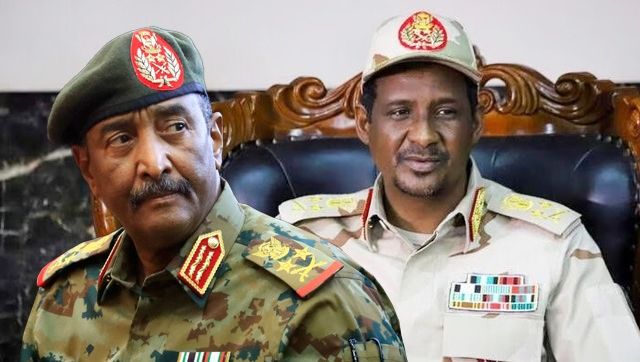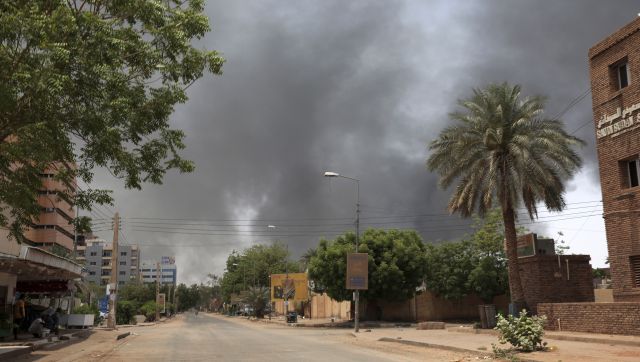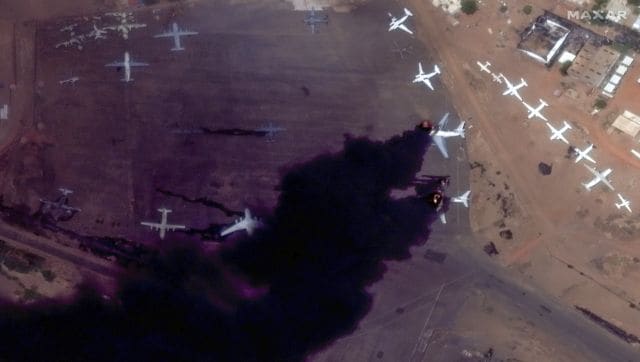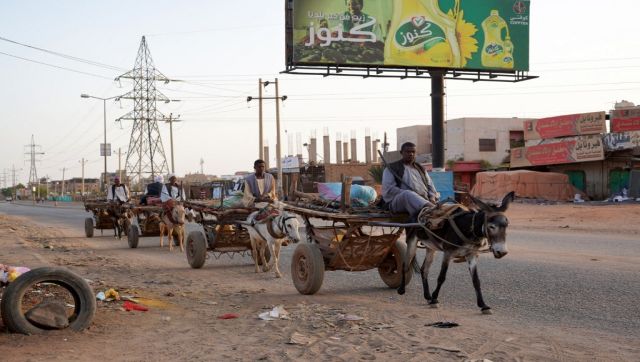Sudan, once the largest and one of the most geographically diverse states in Africa that split into two countries in July 2011, is witnessing unprecedented violence. At least 97 civilians have been killed and another 595, including combatants have been wounded after violence broke out in the African nation on Saturday as forces loyal to two rival generals are vying for control. The fighting that took place over the weekend has also killed an
Indian
, a man from Kerala identified as Albert Augestine. The Indian embassy in Sudan tweeted, “It has been reported that Mr Albert Augestine, an Indian National working in a Dal Group Company in Sudan who got hit by a stray bullet yesterday succumbed to his injuries. Embassy is in touch with family and medical authorities to make further arrangements.” The Indian embassy — along with the US and UK ones — have issued advisories asking their citizens in the embattled country to take utmost precautions and “stay indoors”. The Indian mission also urged that those planning to travel to the African nation should defer their visit. The violence has forced the United Nations’ World Food Programme to
suspend operations
in the country. Moreover, the US, China, Russia, Egypt, Saudi Arabia, the UN Security Council, EU and African Union have appealed for a quick end to the hostilities that threaten to worsen instability in an already volatile wider region. But why is the African nation witnessing gunfire and violence? Who are the factions involved? What has caused this? Here’s what you need to know. A struggle for power The clashes are a result of a power struggle between the Sudan army headed by General Abdel Fattah al-Burhan and the commander of the paramilitary Rapid Support Forces (RSF), Mohamed Hamdan Dagalo — better known as Hemedti. [caption id=“attachment_12463772” align=“alignnone” width=“640”] The fighting in Sudan is between the army headed by General Abdel Fattah al-Burhan (left) and the commander of the paramilitary Rapid Support Forces (RSF), Mohamed Hamdan Dagalo — better known as Hemedti.[/caption] The two heads were allies until recently; they had worked together to oust former leader Omar al-Bashir in 2019 and played a pivotal role in the military coup in 2021. Also read:
Timeline | How unrest in Sudan continues since military coup that ousted Omar al-Bashir
However, various disagreements — over how the country should be run, the integration of the RSF into the country’s military — led to both sides fighting amongst themselves. These hostilities led to a fight of dominance, which is now being played out in the country. Rivalry between army and RSF The RSF was formed by former president Omar al-Bashir to crush a rebellion in Darfur — a western region in Sudan. The RSF, also known by the name of Janjaweed, became synonymous with widespread atrocities. It has also been accused of human rights abuses, including the massacre of more than 120 protesters in June 2019. In 2013, Bashir gave the leaders of the RSF military ranks. Following the ouster of Bashir in 2019, a transition government dominated by civilians came into power. However, they were overthrown by the military in 2021 with the cooperation of the RSF. Since then both groups have been competing for legitimacy and control of the country. And in recent months the ties between Burhan and Dagalo have worsened. The two powerful leaders continue to clash over how the RSF should be integrated into the armed forces and what authority should oversee the process. The army wants the transition to happen within two years while the RSF says it would take 10 years. [caption id=“attachment_12463792” align=“alignnone” width=“640”]
The fighting in Sudan is between the army headed by General Abdel Fattah al-Burhan (left) and the commander of the paramilitary Rapid Support Forces (RSF), Mohamed Hamdan Dagalo — better known as Hemedti.[/caption] The two heads were allies until recently; they had worked together to oust former leader Omar al-Bashir in 2019 and played a pivotal role in the military coup in 2021. Also read:
Timeline | How unrest in Sudan continues since military coup that ousted Omar al-Bashir
However, various disagreements — over how the country should be run, the integration of the RSF into the country’s military — led to both sides fighting amongst themselves. These hostilities led to a fight of dominance, which is now being played out in the country. Rivalry between army and RSF The RSF was formed by former president Omar al-Bashir to crush a rebellion in Darfur — a western region in Sudan. The RSF, also known by the name of Janjaweed, became synonymous with widespread atrocities. It has also been accused of human rights abuses, including the massacre of more than 120 protesters in June 2019. In 2013, Bashir gave the leaders of the RSF military ranks. Following the ouster of Bashir in 2019, a transition government dominated by civilians came into power. However, they were overthrown by the military in 2021 with the cooperation of the RSF. Since then both groups have been competing for legitimacy and control of the country. And in recent months the ties between Burhan and Dagalo have worsened. The two powerful leaders continue to clash over how the RSF should be integrated into the armed forces and what authority should oversee the process. The army wants the transition to happen within two years while the RSF says it would take 10 years. [caption id=“attachment_12463792” align=“alignnone” width=“640”] Smoke is seen rising in Khartoum, Sudan. The nation saw fierce clashes over the weekend. AP[/caption] The weekend violence The fighting that broke out on Saturday was the result of the members of the RSF being redeployed around the country in a move that the army saw as a threat. The Burhan-led army issued a statement as RSF forces were deployed, saying the mobilisation represented a “clear violation of law”. On Saturday, the fighting began at a military base south of the capital Khartoum, with both sides accusing the other of initiating attacks. The fighting quickly spread to other parts of the city, including around the military’s headquarters, the airport and the presidential palace. An Al Jazeera report stated that heavy artillery being fired could be heard and even fighter jets were witnessed in several districts. [caption id=“attachment_12463832” align=“alignnone” width=“640”]
Smoke is seen rising in Khartoum, Sudan. The nation saw fierce clashes over the weekend. AP[/caption] The weekend violence The fighting that broke out on Saturday was the result of the members of the RSF being redeployed around the country in a move that the army saw as a threat. The Burhan-led army issued a statement as RSF forces were deployed, saying the mobilisation represented a “clear violation of law”. On Saturday, the fighting began at a military base south of the capital Khartoum, with both sides accusing the other of initiating attacks. The fighting quickly spread to other parts of the city, including around the military’s headquarters, the airport and the presidential palace. An Al Jazeera report stated that heavy artillery being fired could be heard and even fighter jets were witnessed in several districts. [caption id=“attachment_12463832” align=“alignnone” width=“640”] A satellite image shows two burning planes at Khartoum International Airport, Sudan. The military and the RSF are battling for control of the chaos-stricken nation for a second day. Maxar Technologies/AP[/caption] The Associated Press further reported that heavy fighting involving armoured vehicles, truck-mounted machine guns and war planes raged on Sunday in Khartoum, adjoining city of Omdurman. Fighting was also reported around Khartoum International Airport and state television headquarters. Satellite images analysed by the Associated Press showed columns of black smoke covering the sky over the capital’s airport. The images by Maxar Technologies showed two large planes on fire, and four others damaged. Airlines have suspended flights to the Sudanese capital. Residents have been holed up in their houses. “Khartoum has become a battlefield,” Tahani Abass, a prominent Sudanese rights advocate, told Sky News, adding, “The situation is very dire, and we don’t know when it will be ended.” Three UN World Food Programme (WFP) workers were among those killed in the clashes. Another two were injured while carrying out duties and a humanitarian aircraft was damaged, “seriously impacting” WFP’s work, a spokesperson said. On Sunday, the two factions agreed to a three-hour humanitarian pause from 4 pm to 7 pm local time. However, gunfire could still be heard and plumes of smoke continued to be seen in live telecasts from Khartoum. The world’s response The international community has condemned the violence, calling for an immediate halt to the battle. UN Secretary General Antonio Guterres condemned the outbreak of fighting and called for calm. “The Secretary-General calls on the leaders of the Rapid Support Forces and the Sudanese Armed Forces to immediately cease hostilities, restore calm and initiate a dialogue to resolve the current crisis,” said Stephane Dujarric, Guterres’s spokesman. [caption id=“attachment_12463872” align=“alignnone” width=“640”]
A satellite image shows two burning planes at Khartoum International Airport, Sudan. The military and the RSF are battling for control of the chaos-stricken nation for a second day. Maxar Technologies/AP[/caption] The Associated Press further reported that heavy fighting involving armoured vehicles, truck-mounted machine guns and war planes raged on Sunday in Khartoum, adjoining city of Omdurman. Fighting was also reported around Khartoum International Airport and state television headquarters. Satellite images analysed by the Associated Press showed columns of black smoke covering the sky over the capital’s airport. The images by Maxar Technologies showed two large planes on fire, and four others damaged. Airlines have suspended flights to the Sudanese capital. Residents have been holed up in their houses. “Khartoum has become a battlefield,” Tahani Abass, a prominent Sudanese rights advocate, told Sky News, adding, “The situation is very dire, and we don’t know when it will be ended.” Three UN World Food Programme (WFP) workers were among those killed in the clashes. Another two were injured while carrying out duties and a humanitarian aircraft was damaged, “seriously impacting” WFP’s work, a spokesperson said. On Sunday, the two factions agreed to a three-hour humanitarian pause from 4 pm to 7 pm local time. However, gunfire could still be heard and plumes of smoke continued to be seen in live telecasts from Khartoum. The world’s response The international community has condemned the violence, calling for an immediate halt to the battle. UN Secretary General Antonio Guterres condemned the outbreak of fighting and called for calm. “The Secretary-General calls on the leaders of the Rapid Support Forces and the Sudanese Armed Forces to immediately cease hostilities, restore calm and initiate a dialogue to resolve the current crisis,” said Stephane Dujarric, Guterres’s spokesman. [caption id=“attachment_12463872” align=“alignnone” width=“640”] Men ride donkey-pulled carts along a deserted street in Khartoum’s twin city Omdourman. AFP[/caption] Antony Blinken of the US said the situation in Sudan was “fragile” but insisted there was still an opportunity to complete a transition to a civilian-led government. Even China expressed concern with its ministry of foreign affairs urging both sides to pursue a ceasefire and prevent further escalation. Consequences for Sudan When the fighting will end is unclear, but there are grave repercussions for Sudan if the violence continues. The fighting could fragment an already broken country and worsen political turbulence. Moreover volatility in Sudan will affect its neighbours — Ethiopia, Chad and South Sudan. Even though Sudan is one of Africa’s poorest countries, its natural resources and its strategic location on the Red Sea make it an important country when it comes to geopolitics. Russia is keen to establish a naval base on the coast, a move that Washington wants to prevent. Also, the US doesn’t want the nation to return to the days when it hosted terrorists groups like Osama Bin Laden’s Al-Qaeda. However, even as diplomats from the country and outside try to put a stop to the violence and move Sudan to a civilian rule, it is the ordinary man in Sudan who will have to endure this uncertainty and live with a fear for their lives. With inputs from your agencies Read all the
Latest News
,
Trending News
,
Cricket News
,
Bollywood News
, India News
and
Entertainment News
here. Follow us on
Facebook
,
Twitter
and
Instagram
.
Men ride donkey-pulled carts along a deserted street in Khartoum’s twin city Omdourman. AFP[/caption] Antony Blinken of the US said the situation in Sudan was “fragile” but insisted there was still an opportunity to complete a transition to a civilian-led government. Even China expressed concern with its ministry of foreign affairs urging both sides to pursue a ceasefire and prevent further escalation. Consequences for Sudan When the fighting will end is unclear, but there are grave repercussions for Sudan if the violence continues. The fighting could fragment an already broken country and worsen political turbulence. Moreover volatility in Sudan will affect its neighbours — Ethiopia, Chad and South Sudan. Even though Sudan is one of Africa’s poorest countries, its natural resources and its strategic location on the Red Sea make it an important country when it comes to geopolitics. Russia is keen to establish a naval base on the coast, a move that Washington wants to prevent. Also, the US doesn’t want the nation to return to the days when it hosted terrorists groups like Osama Bin Laden’s Al-Qaeda. However, even as diplomats from the country and outside try to put a stop to the violence and move Sudan to a civilian rule, it is the ordinary man in Sudan who will have to endure this uncertainty and live with a fear for their lives. With inputs from your agencies Read all the
Latest News
,
Trending News
,
Cricket News
,
Bollywood News
, India News
and
Entertainment News
here. Follow us on
Facebook
,
Twitter
and
Instagram
.
Sudan conflict kills 97: The fight between rival generals for the control of the nation, explained
FP Explainers
• April 17, 2023, 10:16:40 IST
Violence has broken out in Sudan with heavy gun firing killing 97 civilians in Khartoum and other cities. The fighting is a result of a power struggle between the country’s military led by General Abdel Fattah al-Burhan and the paramilitary Rapid Support Forces (RSF) headed by Mohamed Hamdan Dagalo
Advertisement
)
End of Article